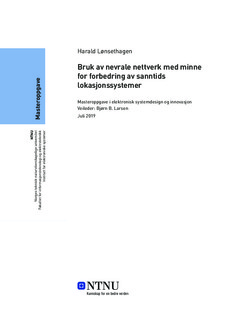| dc.description.abstract | Sanntids lokaliseringssystemer (SLS) har hatt en signifikant økning i anvendelser i det vi beveger oss inn i æraen av tingenes internett. Tradisjonelle lokaliseringsløsninger sliter med å møte de stadig økende nøyaktighetskrav fra moderne produkter og tjenester.
Kunstig intelligens (KI) har de siste årene vist seg å være et særdeles nyttig verktøysett for å løse problemer av svært ulik art. Stadig flere KI-teknikker blir også anvendt innenfor lokaliseringssystemer.
Bransjen for delvis- eller helt selvkjørende biler har vist spesiell stor interesse for lokalisering da det er helt essensielt for selvkjørende biler å kjenne til sin posisjon i omgivelsene.
Formålet med denne oppgaven er å undersøke om bruk av et nevralt nettverk med minne, som tar inn sanntidsdata fra et SLS, kan lage et posisjonsestimat som har høyere nøyaktighet enn det originale posisjonsestimatet fra samme SLS. Videre ble det valgt å benytte blåtann fordi dette er en radioteknologi som lett lar seg integrere og fordi teknologien finnes i de fleste kjøretøy.
Quuppa Intelligent Locating System (QILS) er markedets ledende leverandør av lokaliseringssystem basert på blåtann. Med sine nyvinnende mottakere, hver besittende av et komplisert antenne-array, er det mulig å beregne estimat for ankomstvinkel og derigjennom posisjon. QILS tilbyr et API som tilgjengeliggjør sanntidsdata, som posisjonsestimat, filtrert posisjonsestimat, usikkerhets-kovarians matrise samt andre data. Med dette som bakgrunn ble QILS valgt som sanntids-lokaliseringssystemet for denne oppgaven.
Det er i denne anledning anskaffet og anvendt et eksemplar av QILS, som inkluderer sendere, mottakere og en prosesseringsenhet. Utstyret er satt opp på et lager med mange hindringer, med hensikt å etablere et testoppsett som kan representere et kaotisk veikryss for å gjøre undersøkelsene og eksperimentering med nevrale nett i omgivelser som er realistiske.
For å gjennomføre målinger og innhente data ble en mobil plattform besittende av flere blåtann-sendere, en laser og laptop realisert. Videre ble en metodikk utformet for å konstruere gode og store mengder treningdata.
Resultatene viser at det nevrale nettverket lærer seg å predikere posisjoner, men nøyaktigheten overstiger ikke estimatene fra QILS. Validering av nettverket over det fullstendige datasettet gir en score på 0.000508 til nettverket, sammenlignet med 0.000501 til posisjonsestimatene til Quuppa. Anbefalt videre arbeid er å gjøre ytterligere undersøkelser av ulike parametre til nettverket, og bruken av andre nettverksarkitekturer. | |
| dc.description.abstract | Real-Time Locating Systems (RTLS) has had a significant increase in applications as we move into the era of the Internet of Things. Traditional localization solutions are struggling to meet the ever-increasing accuracy requirements of modern products and services.
Artificial Intelligence (AI) has in recent years proved to be a particularly useful toolkit to solve very different problems. More and more AI-techniques are also being used in localization systems.
The industry for partly or completely driverless cars has shown particular interest in localization as it is absolutely essential for driverless cars to know their position in the surroundings.
The purpose of this task is to investigate whether using a neural network with memory, which captures real-time data from an RTLS, can create a position estimate that has higher accuracy than the original position estimate from the same RTLS. Furthermore, it was chosen to use Bluetooth because this is a radio technology that can easily be integrated and because the technology is found in most vehicles.
Quuppa Intelligent Locating System (QILS) is the market leader in the location system based on Bluetooth. With its innovative receivers, each possessing a complex antenna array, it is possible to calculate the Angle of Arrival estimate and thereby the position. QILS provides an API that exposes real-time data, such as position estimate, filtered position estimate, uncertainty covariance matrix, and other data. With this as background, QILS was chosen as the RTLS for this task.
For this reason, a copy of QDK, which includes transmitters, receivers, and a processing unit, has been acquired and used. The equipment is set up on a warehouse with various obstacles, intended to establish a test set-up that can represent a chaotic junction to make the investigations and experimentation with neural networks in realistic environments.
In order to carry out measurements and obtain data, a mobile platform possessing several Bluetooth transmitters, a laser, and a laptop was realized. Furthermore, a methodology was designed to construct high quality and large amounts of training data.
The results show that the neural network learns to predict positions, but the accuracy does not exceed the estimates of QILS. Validation of the network over the complete dataset gives a score of 0.000508 to the network, compared to 0.000501 to the position estimates of Quuppa. Recommended further work is to further investigate various parameters of the network and the use of other network architectures. | |
